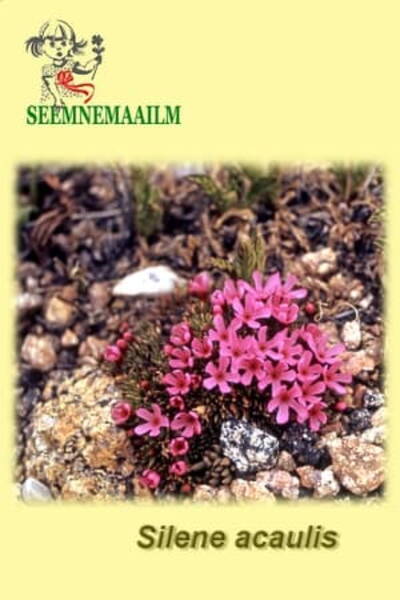Your shopping cart is empty!
Moss campion
Moss campion - Silene acaulis.
Distributed throughout the Arctic zone of the Northern Hemisphere.
A perennial plant that forms dense, compact turf up to 10 cm in height, which is profusely covered in summer with pink flowers up to 2 cm in diameter.
The leaves are narrow and small. Blooms in June-August. It has several varieties and varieties.
The plant is winter-hardy down to -40 °C (Z2 - Z7), but spring shade from the sun is desirable.
Easily propagated by seeds, blooming in the second year. Seedlings are unpretentious, but require moderate, even watering and good lighting.
Vegetatively propagated by careful division and cuttings. When planted correctly, it lives in one place for many years. Planted in well-drained, sunny, but protected from midday rays areas. The plant does not like overheating. The soil is preferably loose, slightly acidic, with the addition of sand and crushed stone. It cannot tolerate replanting as a whole bush, as it has a tap root.
It is moisture-loving, but dies from stagnation of water on the soil surface. To drain excess water, the plant is mulched with fine crushed stone in a layer of at least 3 cm.
Location: prefer sunny places. In shaded places they lose their decorative effect, bloom weakly, and the stems become elongated.
Soil: requires slightly acidic, well-drained soil.
Care: minimal watering.
Old cushion-shaped plants gradually thin out in the center, so after flowering (May-July) they must be significantly shortened in order to regain their characteristic shape the following year.
Reproduction: sowing seeds in March-April. 1.0 g = 2100 seeds.
It can be propagated by dividing the bush in the spring, as soon as the plants begin to grow.
Use: for flower beds, ridges, borders, rocky areas.
Partners: good in combination with blue gentians, bells, violets.
Distributed throughout the Arctic zone of the Northern Hemisphere.
A perennial plant that forms dense, compact turf up to 10 cm in height, which is profusely covered in summer with pink flowers up to 2 cm in diameter.
The leaves are narrow and small. Blooms in June-August. It has several varieties and varieties.
The plant is winter-hardy down to -40 °C (Z2 - Z7), but spring shade from the sun is desirable.
Easily propagated by seeds, blooming in the second year. Seedlings are unpretentious, but require moderate, even watering and good lighting.
Vegetatively propagated by careful division and cuttings. When planted correctly, it lives in one place for many years. Planted in well-drained, sunny, but protected from midday rays areas. The plant does not like overheating. The soil is preferably loose, slightly acidic, with the addition of sand and crushed stone. It cannot tolerate replanting as a whole bush, as it has a tap root.
It is moisture-loving, but dies from stagnation of water on the soil surface. To drain excess water, the plant is mulched with fine crushed stone in a layer of at least 3 cm.
Location: prefer sunny places. In shaded places they lose their decorative effect, bloom weakly, and the stems become elongated.
Soil: requires slightly acidic, well-drained soil.
Care: minimal watering.
Old cushion-shaped plants gradually thin out in the center, so after flowering (May-July) they must be significantly shortened in order to regain their characteristic shape the following year.
Reproduction: sowing seeds in March-April. 1.0 g = 2100 seeds.
It can be propagated by dividing the bush in the spring, as soon as the plants begin to grow.
Use: for flower beds, ridges, borders, rocky areas.
Partners: good in combination with blue gentians, bells, violets.
Bot. syn.: Cucubalus acaulis L., Silene bryoides Jord. (ssp.), Silene exscapa All. (ssp.).












